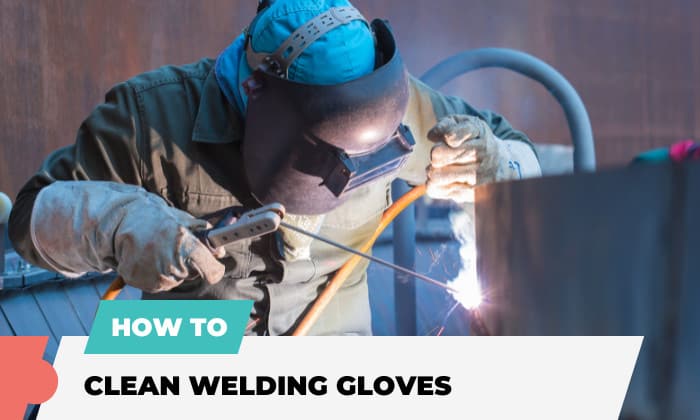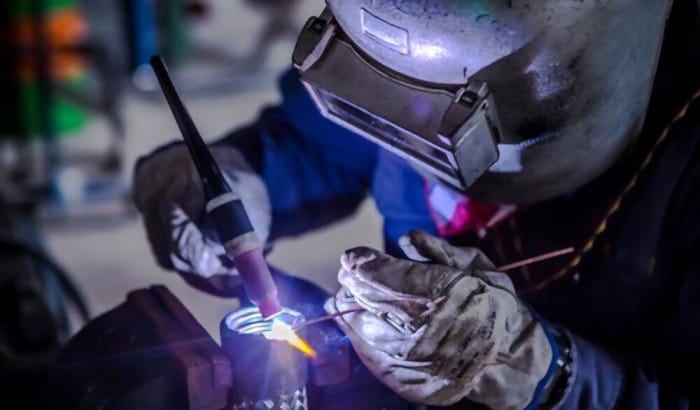Welders usually work with hazardous tasks regarding heat, flames, and electricity. As a result, their welding gloves catch a lot of debris such as metal dust and dirt. If you don’t wash welding gloves, those are very likely to irritate your hands.
Never underestimate the importance of dirt-free welding gloves. Aside from benefiting sensitive skin, cleaning gloves frequently helps soften their materials. Hence, they can fit your hands snugly.
Washing them properly can extend their life and remove bad odors as well. If you’re unclear about how to clean welding gloves, we’ll give you step-by-step guides to wash various materials, including leather, synthetic, heat-resistant silicone, and cotton.
Table of Contents
Step-By-Step to Clean Welding Glove
I’d recommend you check the gloves’ instructions before washing them. For instance, some gloves are equipped with a foiling layer, boasting welding gloves’ heat resistant feature. These have cleaning precautions required.
Leather is more common than other materials when it comes to welding gloves. Manufacturers usually use 1 type of leather or combine several to produce ultimate gloves.
- TIG gloves are made from goatskin, so they are classified as lightweight welding gloves. The flexibility and light weight make it ideal for precise tasks.
- MIG gloves are perfect for construction and tough jobs. They are constructed from cow or goat grains, offering higher protection due to high-heat resistance.
- Cow-split leather is preferably used to produce stick gloves. You can put on these gloves when handling missions at the highest risk.
What to prepare to clean leather gloves
- Cold or room temperature water
- Clean towels
- Soft-bristle brush/toothbrush
- Leather cleaner/PH-neutral soap/saddle soap/moisturizing soap
- Vinegar
- Baking soda
Step 1: Remove debris on gloves
Wipe off debris such as dirt and metal dust on gloves using a dry cloth, a soft-bristled brush, or a toothbrush.
Step 2: Wash gloves
Despite long welding gloves or short ones, you can follow the same steps to wash them. Moreover, you can put gloves on to clean them.
You should use a specialized leather glove cleaner, saddle soap, moisturizing soap, or pH-neutral soap as long as they don’t damage the natural oil of the leather. Choosing the correct soap will maintain the leather’s softness and comfort as wearing gloves.
Never wash leather gloves in washing machine and dry them in the dryer since the unsuitable heat and cycle can shrink and stretch gloves.
- Dip a clean rag into the water and scrub stains not removed in the first step yet.
- To wash leather work gloves with more marks, rinse them with cold or room-temperature water.
- Add cleaner to the balm of the gloves. Rub your hands until bubbles form and get rid of stains.
- Let soap work from 30 seconds to 2 minutes, depending on how tough the stains are. After that, you can brush them as normal before rinsing them with clean water.
Step 3: Rinse and soak up water
I’d suggest wiping off traces of detergent on gloves with a damp cloth. Then, wash with cold water to fully clean leather welding gloves.
After rising, press gently to eliminate water. You can wrap wet gloves into a dry towel which will soak up excess moisture.
Step 4: Clean glove interior
Turn gloves inside out to clean the interior as well.
- Combine white vinegar and water at a ratio 1: 1 to have disinfectant liquid. Then, spray it into interior gloves to remove odors. You should never let vinegar come into contact with the glove exterior, as it will ruin the flame-resistant layer.
- If you don’t want to get them wet, just sprinkle baking soda to deodorize smells. Add 1-2 tablespoons to interior gloves thoroughly. Let it work for 2 hours in cool and dry places. Then, vacuum it to avoid a powdery feeling when wearing gloves.
Step 5: Air-dry
Hang your gloves to dry them naturally under the shade. You should stretch them until they dry. This way will make them not harden after drying. Using a fan is a safe option.
As they are semi-dry, you can wear them till they are dried. The gloves will embrace your hands. It is exclusively good for TIG gloves.
Step 6: Condition
Leather always requires conditioners. The product keeps it soft, shiny, and oily and adds moisture. If not, your gloves will be stiff and hard to wear, causing reduced productivity.
Apply conditioners to a towel and rub your gloves in circular motions. Never choose flammable conditioners.
Synthetic gloves are preferably made from Kevlar which is a high-end material. You will be amazed at its heat resistance since it won’t melt exposed to temperatures below 800F.
What to prepare:
- A washing machine and dryer
- Laundry detergent
Step 1: Wash gloves
- Remove dust and dirt from gloves before putting them into the washing machine
- Add powder or liquid laundry detergent to get rid of stains and unpleasant smells
- Use warm or hot water as long as the temperatures should be under 400F to wash gloves for 15 minutes.
- Set up rinsing mode to ensure the gloves are detergent-free before drying them.
Step 2: Dry
Drying synthetic gloves takes a few minutes. Then, you can toss them into the dryer at 170F.
For Heat-resistant silicone gloves
You can clean heat-resistant silicone welding gloves either by hand-washing or washing machine, whichevery is more convenient for you. Both methods require hot water and laundry detergents to wash gloves.
As they are heat-resistant gloves, you can consider drying them in the dryer or by air.
There are 2 ways to clean cotton gloves: hand washing or washing machine, with the former being better than the latter to avoid ruining the fabric. If you choose the washing machine, put them into a mesh bag before washing.
Due to the material, use cold or warm water and mild detergents.
Also, using artificial heat can damage your gloves, so air drying is an ideal choice.
Other Helpful Tips
Maintain welding gloves in good shape
When gloves are dried, they become inflexible to put on, especially leather welding gloves. Hence, we’ll guide you through 3 ways to turn stiff gloves into soft gloves.
- Submerge gloves in warm water before using them. In detail, 180F is reasonable for softening leather a little.
- Wear gloves right after gloves are dried. They will fit your hands snugly. If you cannot wait until the gloves drain out completely, wear them while they are still wet. They will dry over time.
- Another way is to massage your leather gloves to cushion them.
Store welding gloves in the right places
If you don’t put on gloves after drying them, let’s find appropriate places to store them. Keep your gloves in cool, dry, and dark areas.
FAQs
Why is it important to clean welding gloves?
Cleaning welding gloves provide you with a lot of benefits.
- Eliminate dangerous substances that are built up during your work.
- Maintain softness and flexibility so you can perform tasks effectively.
- Washing welding leather gloves the right way will retain the glove form and features. Indeed, taking care of gloves regularly can extend the gloves’ lifespan.
- Sweat is one of the common reasons for bad odor while wearing gloves. Cleaning them frequently also removes the smell.
What can I do with old welding gloves?
Old welding gloves usually have punctures or are shrunk when exposed to high heat, threatening your safety. To protect your health, buy heat shields, and attach them to the back of your gloves.
Another way is to cut the bottom of old gloves, creating a hole for your thumb. Then, wear your gloves, and put on the bottom gloves on the outside. It acts as a protective layer.
Conclusion
You are indeed equipped with some information about how to clean welding gloves. The cleaning process is not complicated, but you should pay extra attention when cleaning leather gloves for welding.
Washing welding gloves is significant for your safety while working. They can also encourage you to accomplish tasks. Also, you should take care of gloves properly to prolong their longevity as they are rather expensive investments.

This is Edward Manning, the editor in chief of Construction Informer. Quite a bit of my time is spent researching the market and interviewing experts in the field so that I can give you reliable information.







